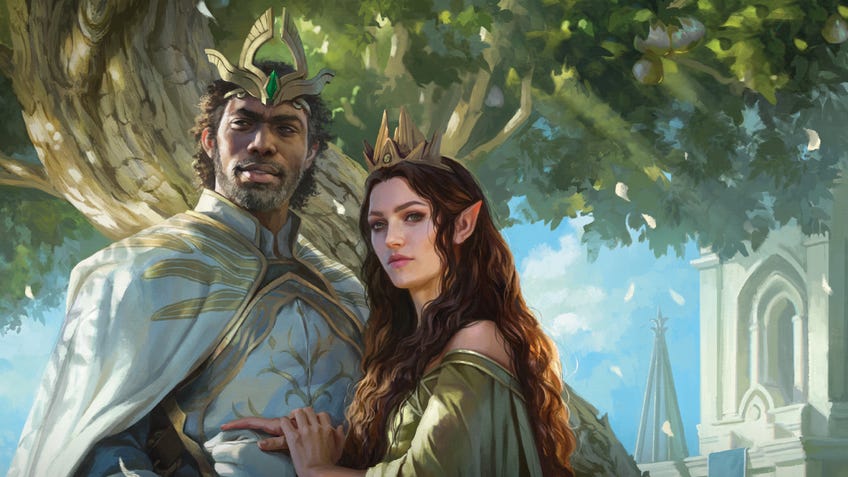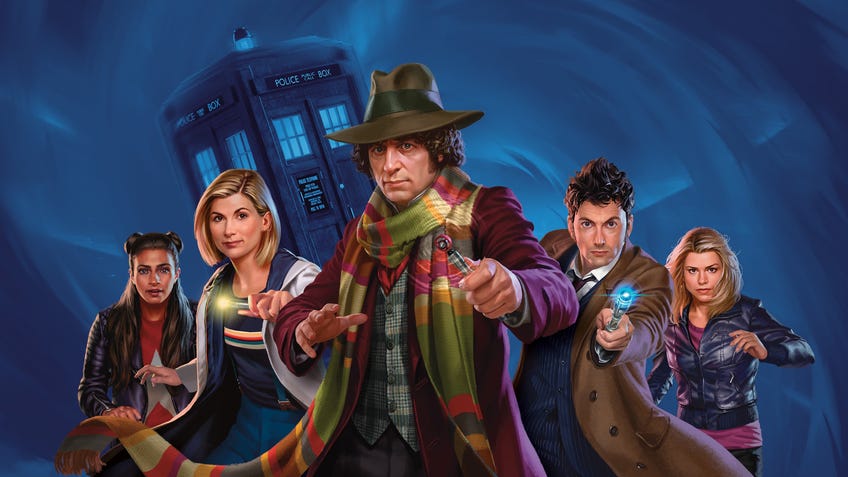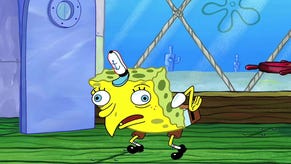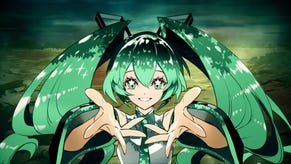Magic: The Gathering's uncanny celebrity cameos are the worst part of its great Doctor Who set
Bradley Walsh, Game Show Host.
Magic: The Gathering’s Universes Beyond initiative arrived on the scene in 2020 not with a bang, but an almighty flop. (And not under that exact name just yet, either.) For some reason, someone at Wizards of the Coast decided that the best way to get players excited about the idea of MTG cards with licensed pop-culture tie-ins was Rick Grimes and the cast of The Walking Dead - a TV show that had become largely irrelevant well before the ink on that particular deal was likely signed.
From there the warning shots were fired. No longer were MTG cards limited to the multiple planes of its internal story and lore that had been built up over the course of 30-odd years. Now, anything was fair game. Books, TV shows, films, video games. A vision of Magic: The Gathering’s future seemed unerringly akin to the wall of Funko Pops at every other convention merch booth.
Reception was not great. Core MTG fans were largely against the idea, worrying that it set a precedent for their favourite trading card game to become yet another advertising space for giant corporate brands and their properties.
What really poured salt into the wound was the fact that these Walking Dead promotional cards were not just alternate art duplicates of old Magic cards - as tends to be the case for most Secret Lair drops, like the recent Princess Bride set - but were instead original, mechanically unique cards that would not be available anywhere else. If the rules text on Negan, the Cold-Blooded seemed to make for a fun new Commander for your deck then tough luck - it’s either a picture of Jeffrey Dean Morgan or it’s nothing.
After The Walking Dead, a vision of Magic: The Gathering’s future seemed unerringly akin to the wall of Funko Pops at every other convention merch booth.
Likely with a forced hand, Wizards of the Coast has since released alternate versions of some of these cards that provide in-universe characters bearing the same rules text. Rick, Steadfast Leader can now instead be played as Greymond, Avacyn’s Stalwart, for example.
The Walking Dead cards generated some pretty sizeable backlash straight from the offset, setting up Universes Beyond with a big chain around its neck before the new crossover brand had even officially christened. The Universes Beyond moniker was retroactively applied ahead of last year’s release of the Warhammer 40,000 Commander decks.

You’d think that this would lead Wizards of the Coast to renege on its attempts to shoehorn in other properties to its cardboard ecosystem. But if Fortnite has taught us anything it’s that nothing prints money quite like a bit of corporate brand synergy - and nothing gets your average pop-culture consumer to buy something quicker than by dressing it in the clothes of their favourite film, book or TV show.
That’s not to say the very nature of a crossover is necessarily a cursed chalice. This year’s Tales from Middle Earth was a stand-out success for Universes Beyond. It provided a faithful and gorgeously realised recreation of the Lord of the Rings, The Hobbit and the world of Middle-earth. It was a complete set, with Commander decks, boosters and Limited format games. While Tales from Middle-earth's cards were a fair bit overpriced at retail, it was all generally well-received.
Tales from Middle-earth provides an almost perfect example of why Magic: The Gathering’s latest Doctor Who set rubs me up the wrong way so much.

Doctor Who as a brand also has a very dedicated fanbase and a long heritage that, while nowhere near as widely beloved as Lord of the Rings, puts it in a similar position for its turn as a Universes Beyond set. It too received a fully designed collection of cards and four unique Commander decks. It is also, from what I’ve played of it so far, a lovingly created and faithful adaptation with fun mechanics that set it apart from other releases.
But when I look at the way it was released, and I look at the art on the Doctor Who MTG cards, a schism starts to appear between Tales from Middle-earth and this new collection. One that seems to share pretty much every problem first highlighted by that initial salvo of The Walking Dead Secret Lair cards. They don’t fit the theme, they’re shoehorning in these weird celebrity cameos and, most egregiously, they’re far too scarce for the average player.
The theming lends a sort of annoying inconsistency to your decks and the board state that might be funny at first glance but becomes rather grating over time.
Let’s start with the theming. It’s ironic that Magic: The Gathering’s world and the one featured in Doctor Who feel so disparate. They both feature all-powerful travellers who pop from world to world going on adventures. But at the end of the day, despite how it might dip into other genres like cyberpunk or 1920s gangster movies, MTG’s world is one of fantasy. It’s orcs, goblins, dragons and magical MacGuffins.
That’s why that original Rick Grimes card from The Walking Dead feels so uncanny amongst your other Magic cards. He’s just some guy, with a police badge and a gun. He’s not a planeswalker, knight or wizard. Lord of the Rings was such a perfect crossover with MTG because the gap between the themes and settings in each world is so miniscule; if you somehow didn’t know what Lord of the Rings was before Tales from Middle-earth, upon seeing it in MTG you’d likely think that Wizards of the Coast just fancied making a classic fantasy-themed release.
The Doctor Who cards stick out like a sore thumb. The Fifth Doctor in his cricket outfit or an alien interrupting someone’s wedding day outside a British terrace house just seem so clearly to not be Magic: The Gathering. Even the Warhammer 40,000 decks, which likely would have benefitted from an admittedly less profitable tie-in with the fantasy Age of Sigmar over sci-fi 40k, could skirt past without too much notice. It’s just warriors in armour wielding flaming swords and fighting demons at the end of the day - even if they are sometimes holding machine guns.
I’d never claim that MTG is supposed to be an exceptionally immersive card game. We’ve all attached a pair of boots to an elder god octopus to make it fight faster in our time. Perhaps I’m just having my own Old Man Yells at Cloud moment here, but it lends a sort of annoying inconsistency to your decks and the board state that might be funny at first glance but becomes rather grating over time. And it’s only just begun.
Nothing seems to wind me up more than the cards that depict actual celebrity actors in their Doctor Who roles. Again, Tales from Middle-earth largely avoided this as it drew from Tolkien’s books rather than the Peter Jackson films. Magic's illustrators could make their own interpretations of the characters, with their own stylistically appropriate art. You can’t do that with Doctor Who. It’s a TV show, with actors. When you depict a character, you’re also depicting David Tennant or Christopher Eccleston.

Maybe this is a me problem, but I just can’t bring myself to put a Donna Noble card in my fantasy deck, led by a knight in armour with a flaming hammer, when it depicts British comedy sketch show star Catherine Tate. I don’t want Bradley Walsh, Coronation Street actor and host of The Chase as one of my commanders. And I certainly don’t want an artifact on the board with the quote “Bowties are cool” at the bottom. That’s done enough cultural damage already.
I can have these opinions, and people can disagree with them. And given this Doctor Who set is full of original designs - and good ones at that! - if I want to play with those cards in my deck, I’m just going to have to suck it up. There’s not going to be a thematic, in-universe reprint of the more than 200 cards in the set anytime soon. Either your deck has Matt Smith in it, or it doesn’t have that card at all.
I’m worried that your average Commander night is going to look less like a game of Magic: The Gathering and more like some sort of Space Jam 2 card game.
That's all not to mention that even the cards in the set are already very inaccessible for the average player. If you love Doctor Who and want to pick up a booster pack, good luck with that. You’ll either need to buy one of the four Commander decks for around £50 or grab a Collector Booster - Magic: The Gathering’s most expensive, over-the-top card packs, currently selling for about £22 a pop and the only boosters available for this set.
It’s a step in the wrong direction in my eyes. I’m really worried that your average Commander night is going to look less like a game of Magic: The Gathering and more like some sort of Space Jam 2 card game where you can tap your Batman card to give Walter White haste. It’s already weird seeing these small-time British actors hiding in my card collection, but I think it’s only going to get weirder from here.










